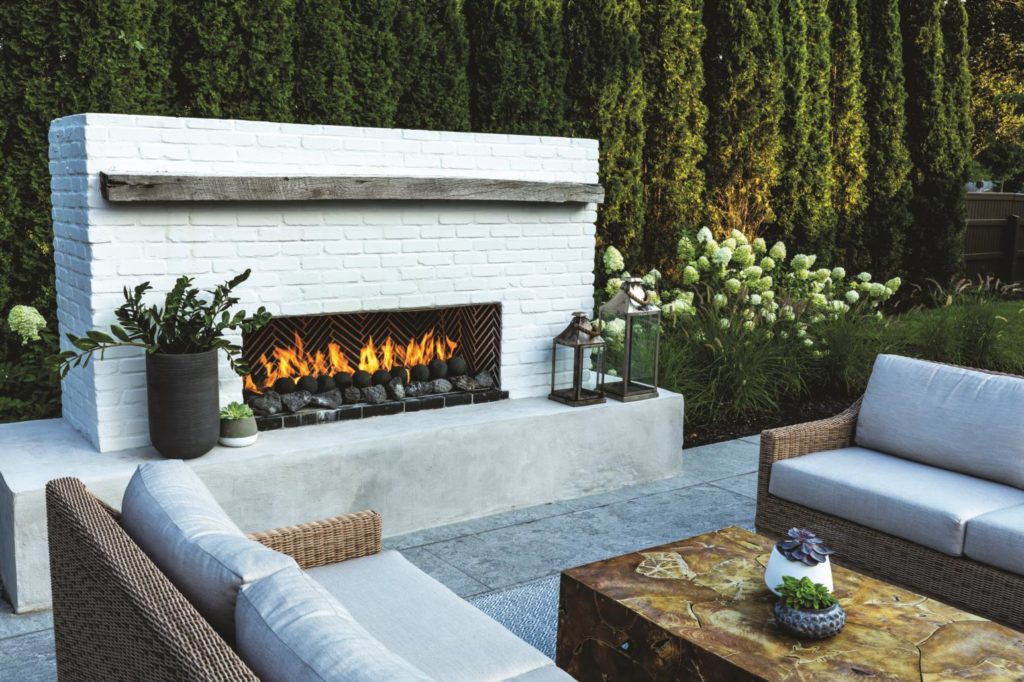Lloyd Fleischer Landscape Design creates a poolside sanctuary using an atypical combination of stylistic elements
“Oversized is what we were going for,” says landscape designer Trent Lloyd when recalling this Newburyport project. Tucked inside a Mark DePiero development, the new Craftsman-inspired house features large windows with very few mullions overlooking a residential cul-de-sac and a busy road. It was the expansive glass that, in large part, sold the clients on the house. It also informed the pool garden by Lloyd Fleischer Landscape Design. The objective was to create a private poolside retreat and lounge area for the family of four.

To start, Lloyd and her business partner, Amy Fleischer, took advantage of a slight grade change on the lot. “Whenever we are dealing with elevation changes, particularly at this house, which is another three to four feet up from grade, we are conscientious about not creating the feeling of a hole. By pulling the stairs out, making them as wide as possible, and terracing them down, we eliminated that potential,” Fleischer explains, noting that those moves also lend a feeling of spaciousness to the landscape.
Simultaneously, the team was charged with ensuring privacy, which was key to the design program. To that end, they planted a mature arborvitae ‘Smaragd’ hedge, which hems the lawn but still allows sun to penetrate.
The overarching design plan centered around the midsize pool featuring a bench on one side—a Lloyd Fleischer Landscape Design signature element—and a dark verde tile and Wet Edge Satin Pebble Matrix treatment, chosen to reflect the trees and fireplace. Of special consideration was an existing gatehouse—now the pool house—which the homeowners wanted to remove but were convinced to keep. “It anchored that corner of the yard and gave nice proportion and dimension to the space,” Fleischer notes. “It also provided a visual buffer to the road.” Additionally, the building breaks up the arborvitae mass and offers some soundproofing qualities.

Opposite that structure is the large-scale fireplace. Standing over 5 1/2 feet tall and 8 feet wide, it is a dramatic focal point. The designers planned for the long-term growth of the arborvitae hedge, hydrangea ‘Limelight,’ and Pennisetum ‘Karley Rose’ to soften the effect. “It’s going to feel like the landscape is embracing that sitting area,” Fleischer predicts. “While the fireplace is white and large, over time it will seem like something coming out of nature, and that space will become even more of a room in a way.” The four Sargent cherry ‘Pink Flair’ trees will surely contribute to that effect.
The fireplace is a wholly customized piece. The team found the salvaged wood slab for the mantel at a stone yard on Cape Cod, and went with Superior Clay black herringbone tile for the firebox juxtaposed with the linear brick in a running blunt pattern on the exterior. “Oftentimes, fireplaces are not particularly attractive when not in use,” Fleischer notes, “so it was important that the interior have an attractive element for when it’s not on.”

Lloyd believes the concrete base speaks to a more modern, industrial feel. And both agree that its gray tone provides a nice transition from the Persian gray limestone elsewhere in the garden against the white of the mantle. “It has kind of a retro feel to it,” Lloyd adds, noting that clients respond to a 1950s style.
To inform material choices and treatments, the team took cues from the house architecture, which includes a brick terrace retaining wall. “In order to celebrate that clean Northern California vibe the homeowners were interested in, we took the bold risk of painting all of that brick white,” Fleischer explains. “That’s not a traditional thing to do here in New England. Brick is a traditional material that we intentionally decided to modernize.”

The fact that the homeowners were, unlike most, uninterested in preserving much lawn area allowed more room for the different elements. “It was a refreshing change not to have that constraint,” notes Fleischer, adding that the lawn was just used as a softening agent; it didn’t dictate the design.
Working with the Craftsman-esque house and the homeowners’ penchant for minimalism, Fleischer and Lloyd grew to appreciate the ways in which varying stylistic elements work together here. They credit their clients with having a keen eye for the well-orchestrated. “They value design and art,” Fleischer notes. “What we did here doesn’t necessarily fall into one category.” In truth, the landscape offers “lots of different points of view.”

